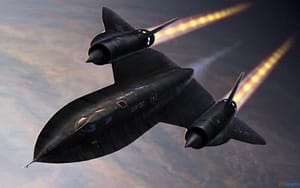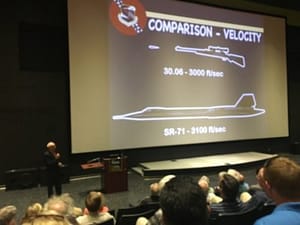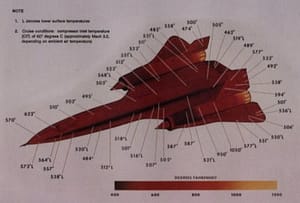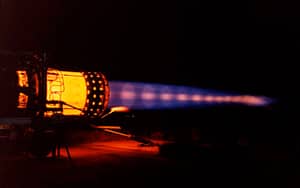The fastest air-breathing Aircraft
To start with – there is a nice video of (former) Top Gear’s Jeremy Clarkson explaining the fastest plane in the world – Lockheed SR-71 Blackbird.
Airplanes. They come in many different shapes and sizes, materials and colours. Some are built to surveil, some are built to take off vertically, and some are built to transport big loads of cargo to the other side of the planet. In this article series, we will look into three different categories of airplanes. This part will be about the fastest aircraft ever flown, the second part will be about the oddest looking ones, and the third part will be about the largest airplanes that have ever been able to lift. In this article, we will look into one of the very few airplanes that have flown faster than Mach 3.0 (~3,675km/h).

SR-71 Blackbird
The plane that we are going to assess is the American Lockheed SR-71 Blackbird, built by the famous Lockheed Skunk Works division. Now let’s not bark around the tree, what is this aircraft really about? It is as of today the world’s fastest manned air-breathing jet ever flown with an official top speed of Mach 3.3, although some claim that it is higher and since some parts of the Blackbird project are still classified – so we can’t know for sure.
“It is a race this jet will not let us lose. The Mach eases to 3.5 as we crest 80,000 feet. We are a bullet now – except faster” – Major Brian Shul, Author of “Sled Driver”.
The SR-71 temperature problem

Retired SR-71 pilot Lt. Col. Ed Feilding illustrates that the plane’s top speed really was “faster than a speeding bullet.”
Because of the astonishingly high speed, the aircraft was travelling at, the canopy was heated up to over 300°C. This meant that its design had to be completely rethought about. The high temperatures are a result of a physical phenomenon that is causing the air molecules at high speeds to be smashed into each other which results in higher pressure which leads to higher temperatures. In easy words: The air molecules can’t get out of the way fast enough so they pile up in front of the jet and give off heat. This meant that the airplane had to be built so that it could both withstand high temperatures, high stress, and be stealthy. Because yes, the Blackbird was using stealth technology. It was actually the first operational aircraft using stealth features. Of course, it did not have a low radar cross section as modern fighters have, the SR-71 had an RCS of about 10m^2 while for instance the F-22 Raptor looks like a marble on the radar. The solution to these three problems was a worked alloy of titanium covered with a corrugated skin, crafted into a stealthy shape. The titanium was used because of its extreme durability, while the corrugated skin was used to deal with the above-presented heat problem because the normal paint would just be curled and split by the high temperatures. Stealth was a brand new idea, and the use of 85% of titanium in the structure was also an almost unexplored area of engineering. When welding the titanium normal tap water could not be used as it was corrosive to the titanium, the same went with the “usually” used cadmium plated tools that

Temperatures of the SR-71 during flight (550°F ~290°C).
also lead to corrosion, which leads to a lot of new tools having to be bought. There were also problems with metallurgical contamination which led to that at a point of the Blackbird production, over 80% of the titanium that was delivered had to be thrown away. Interesting note here: The primary alloy for the SR-71, titanium, was so scarce outside the USSR that the CIA had to import some covertly from the Soviet Union.
Many of you might think that this beautiful bird was at the limit of destruction as it exceeded Mach 3. But at this point, it actually performs best. As a matter of fact, it was built to fly at this speed. At very high speeds of Mach 3+, the SR-71 flight body heats up so much that the metal expands a lot. If the metal pieces of the airplane at this point would have been tightly screwed together, the aircraft would simply expand to its own death, making the expansion push the metal pieces into each other with very serious consequences. This is why the Lockheed Skunk Works division built the Blackbird with big gaps at some points in the structure, resulting in the body dripping fuel, as is explained by the quote below:
“Ironically, the plane was dripping, […] Fuel was seeping through the joints, raining down on the hangar floor. At Mach 3, the plane would expand several inches because of the severe temperature, which could heat the leading edge of the wing to 1,100 degrees. To prevent cracking, expansion joints had been built into the plane. Sealant resembling rubber glue covered the seams, but when the plane was subsonic, fuel would leak through the joints.” – Major Brian Shul, Author of “Sled Driver”.
https://youtu.be/mHjhgeyhuKk
The engines that got the SR-71 to Mach 3

Pratt & Whitney J58 engine with full afterburner engaged.
But what does the SR-71 actually own its speed to? Its engines. The two black “pods” on each side of the flight body are as complex and thought through as the rest of the aircraft. They consist of two Pratt & Whitney J58 engines which were at the time the only American engines built to continuously use afterburners
(which is why the SR-71 consumed so much fuel). Just like previously mentioned with the flight body being built for extreme speeds – so were the engines with their ultimate cruising speed at Mach 3.2. When going supersonic, the air going into the engine is travelling at supersonic speeds, resulting in shockwaves inside of the engine which might lead to engine failure. To get rid of this problem, the inlets to the engines on the SR-71 are “blocked” by a big pointy piece of metal, called a spike, which moves forward and backwards depending on how fast the aircraft is flying. When flying at top speed, the spikes could retract as much as 66 centimetres into the engine, changing the speed of the incoming air to a subsonic 0.5 Mach. It does this to keep the air pressure inside of the engine constant. The same idea is used on among others by the Soviet Sukhoi Su-22 Fitter. However, sometimes when going supersonic, the engines failed in changing the pressure of the incoming air which led to only one of the engines going supersonic. The result of this is heavy jawing which can only be solved by restarting the engine, however often both of the engines were restarted to be sure that the yawing stopped. The energy of the shockwaves at the spike, plus the heat produced by the constantly used afterburners, heated up the compressors to temperatures of over 400°C. Actually, the maximum temperature the engine compressors could work at (427° Celsius) was what limited the speed of the Blackbird. However, studies made in the later years of the 20’th century showed that with the right materials, engine inlets of the SR-71 type could theoreticaly work at speeds as high as mach 6.
The speed was its main defence
But even though the Blackbird was so expensive and hard to build, it did get onto the production line, and it was an enormous success. Not only was it black, had been a secret project and looking like it was from another planet, it was the fastest aircraft the world has ever seen. And more importantly for the US – it was faster than anything the Soviets had ever built. Although it carried electronic countermeasures, the main defensive system of it versus missiles was simply to outrun them, just like quoted from the SR-71 Blackbird documentary on PBS:
“If a surface-to-air missile launch was detected, the standard evasive action was simply to accelerate and outfly the missile”.
The effectiveness of this defence was proved in 1981 when Kelly Johnson, one of the designers of the Blackbird, announced that over 1,000 missiles had been launched towards the SR-71, but none of them had hit. Out of the 32 SR-71s that were built, 12 were lost due to accidents, never because of enemy fire. While talking about weapons and countermeasures, it is needed to say that the SR-71 was never fitted with any weapons. Of course, this was due to many reasons but one was that it was simply not built to shoot. It was built to surveil and take pictures and since it could not (in practical) be shot down it had no need to be fitted with weapons. The Blackbird was only capable to fly for approximately 5,400km which may seem like a lot, but compared to the Lockheed U-2, another reconnassaince aircraft, with a range of over 10,000km, it is (very) inferior. The short range, which was a result of the very thirsty engines, was the reason for the in-air-refueling capability to be fitted with the SR-71.
To the edge of space in a titanium bird

Spacesuit used by the crew of the SR-71.
It flew so high and so fast that the crew needed pressurized space suits when flying it. And it is said that at the maximum altitude of it it was possible to see the curvature of the earth, which refers to this quote by Colonel Alison: “On a clear day you can see forever…”. The service ceiling of 85,000 feet (25,900m) meant that it was an excellent experimental unit for space travels. That, combined with the great speeds of it was two of the reasons why NASA decided to take over the last two Blackbirds after its retirement from the Air Force in 1998. This means that the world’s fastest aircraft was in service from 1966 until NASA retired its two units in 1999, and most of the remaining Blackbirds are today stationed at museums or military bases across the US.
Since the dawn of these airplanes there have been countless missiles and other rocket-propelled aerial vehicles moving faster than Mach 3.3 but there has never been a manned, air-breathing one. We do not know if there will be one in the future – and given the recent developments with UAVs it looks unlikely – but we do know that when the Blackbird entered service with the US Air Force, it was cooler, faster and more astonishing than the world had ever seen before. Gathering information about the enemy while flying at an altitude of 20,000 meters at speeds as high as three times the speed of sound is a true proof of the skill of American Skunk Works engineers. Just being able to accelerate away from a surface-to-air missile and use that feature as a main defence is a huge accomplishment on its own. The Lockheed SR-71 Blackbird will therefore reserve a special place in most aviation lover’s heart.
Additional reading:
- Which fighter is the best – The F-22 Raptor vs The Eurofighter Typhoon
- Read about the trillion dollar project: 5th generation fighter jets too expensive?
- Read about a giant bomber project: The giant bomber of the 30’s – Kalinin K-7.
Sources:
- CIA
- Army.mil
- Aerospaceweb.org
- Wvi.com
- Gizmodo.com

The first one was made toally from Titanium, and only place in the world, that had that much Titanium, was USSR. This statement was told one of the Skunk Works engineers in dokumentary. Even today, C.I.A keeps information how they get the Titanium out from Soviet Union as Top Secret information.
Antti Vepsä Your wrong……. On the SR-71, titanium was used for 85% of the structure, with much of the rest polymer composite materials.
He said “the first one”.
The Titanium came from the USSR because the CIA created a ‘false store front’ business requiring the titanium for their ‘make believe’ product. The USSR had no idea HOW the Titanium they sold was going to be used. The CIA tricked the USSR into selling the Titanium!
A true marvel. Especially considering it was all developed using late 1950’s technology.
The top speed was never officially released, but there are rumors that it was capable of much better than mach four.
Interesting note: The US government bought most of the titanium used in it from Russia, using phantom companies.
The higest speed the SR-71 was said to reach was Mach 4.788
The SR-71 Blackbird is my favorite plane ! I was fortunate enough to see one at A air show in San Antonio ! My question is ! How many sunrises could its pilots see at max speed in a 24 hour period ? Thx.
I heard stories were the MiG-25 Foxbat couldn’t even catch it
Yep, the Blackbird can hit Mach 3.35, whilst the Foxbad can only hit mach 3.2 (with great damage to engines.)
The R-33 (Russian: Вымпел Р-33, NATO reporting name: AA-9 Amos) is a long-range air-to-air missile developed by the Vympel. It is the primary armament of the MiG-31 interceptor, intended to attack large high-speed targets such as the SR-71 Blackbird, the B-1 Lancer bomber, and the B-52 Stratofortress…
Yah its true because they never reveal the true speed of the aircraft the 3.3 top speed of SR 71 is just the tip of an iceberg thats why foxbat cant catch it!
True. The REAL top speed of the SR-71 remains classified, although Hillary probably put that info on her nonsecure private server for hostile foreign countries to see.
When’s Hillary going to be prosecuted? Oh that’s right, everyone is distracted with Kavanaugh at age 17.
Jenn… P L E A S E!!!
A kind of perfection …
all time favorite 🙂
I flew the blackbird
Nice, I’m jealous. Have you been a Blackbird pilot?
SR-71 lindo <3
SR-71 Blackbird !!! Favorite Aircraft !!!
She’s only depand on her’s speed to escape….
That thing leaked gas and took a day to do a 180* turn. Plus look who built it. A North American (the Mustang guys!) Valkyrie B-70 beats this any day.
We’re talking about a plane that can blaze through more than a mile every second , simply outruns missiles and you say the P-51and B-70 can beat it any day?
Al Farrell…..If you are going to comment please do your home work first.
is that more faster than concorde ?
Much faster. Concorde’s Cruise speed was Mach 2,02
BAD ASS PLANE
Always loved this beast
Do blackbird really need stealth? Missile cant even chase her up.
Well it’s never a bad thing to be stealthy I guess
Yeah, not a bad thing at all
Nice article !
Worked this creature in the mid 70’s Habu Baby. Yours Truly,
One of the Batman of SLR.
I don’t know if any of you have ever seen it really flying to mission. In the Late 70’s I was stationed in Japan and saw it take off always at night from Kadena AFB. The base was about 10 miles from where I lived on and you could hear the engine when it took off and if you were lucky you could see the exaust coming out of the engines as it passed through the nite sky on it’s way to wherever it was going. Only saw it land once.
Must have been nice
In the summer of 1968, I was a VISTA Volunteer working in Marysville and Yuba City, 50 miles north of Sacramento, California. My co-worker’s husband was an officer stationed at Beale Air Force Base, eight miles east of Marysville. They invited me to be a guest at their home on the base on weekends. Several times, I looked up to see see this sleek, beautiful black plane landing. She and her husband would both laugh, look at me and say, “You didn’t see that, OK? You didn’t see that plane landing. You can’t tell anyone about it. It doesn’t exist.” Gotcha!!
this jet will take 15min from America to London.I can.t believe it the speed is just too much God bless America
So if missles r rockets and the sr71 is a crazy jet. I do not understand how it cant be hit when rockets got us to the moon or can be icbm’s go well over the speed of the sr71. I see no reason why it cant be hit unless they r using something to either block its trajectory or the sr71 is not what they say it is
It literally out runs the missiles. You can’t compare speed travel inside earth’s atmosphere to travel in space where there is no atmosphere. Apples and oranges. Inside earth’s atmosphere SR71 is king.
WOW! Could There Be Any Aircraft Like This, For Missiles Not To Hit It?, I Guess Am Dreaming
Not being a mathematician, and just thinking about it, to me it makes sense that it couldn’t be hit. In a dead out race where both the SR-71 and missiles crossed the starting line at the exact same time and both at full speed, the SR-71 would lose. BUT, if you take the blackbird flying at Mach 3.3 at 80,000 feet and launch a missile at it from the ground, I can see it. By the time the missile locks onto the target and gets up to speed, the blackbird would be long gone. Remember the missile is firing from a stop at something that is already flying away at Mach 3.3.
1.The Sr-71 Black bird top Speed is fastest Jet Plane with j-58 engine peak speed is Limted too. Up to mack-4 + Mack Speed incatiter says top speed of at Redline Starts at Mack4. + too. Do you agree?? Or disagree?Passed the 1/2 way mark on mack air Speed Meter at top Speed too. Not Mack Number 6 is not true is false statement too! The atendent Exzagerate on the report too! To make you beleave it is true. But is not True is Not Mack 6 too! The Trubines Blades will wroped out of Shape it True!! If they nover heat and turn red hot too. Cause Explosion in the J-58 Engine too! It will happen too! agree!!By the Enginneers how built the Plane in the Blue Prints At Secret Military Base by the U.S.A.F. how built it too! Its, True!!!
As both a long standing admirer of the Blackbird, and in unashamed awe of the technical brilliance required to produce it, I must still put aside the “fan-boy” torrent of “boo-rah” gushing to ask some hard questions. The first is why, more than TWENTY YEARS(!!!) after the Blackbird’s retirement to museums, its full capabilities are still classified, especially since advancements in the speed of function of modern missile guidance and fire control systems, per Moore’s Law, has exceeded ANY(!!!) possible capability of speed of flight by any craft required to physically move through the air, underscored by the interception, in 1984(!!!), by an F-15, a fighter not even as fast as a Mig-25, let alone a Blackbird, but possessing state of the art electronics, for the time, manged to intercept a satellite, in low earth orbit, in OUTER SPACE(!!!), traveling eight times as fast and ten times as high as the Blackbird has ever been presumed to fly? To declare the Blackbird’s true capabilities still secret now is almost as absurd as keeping secret the full speed ability of the Spitfire fighter of WW-2. Has it not occurred to anyone still calling for keeping the secret is just WHOM(!!!) are you keeping it from, since, given the abilities of radars to at least track the Blackbird, irrespective of SAMs ability to hit it, the A-12/SR-71’s full capabilities are already known to any of those who faced it? Last, since the Blackbird never faced the other side’s “varsity”, its “first team”, in the form of deep penetration overflights of the Soviet Union, which, ironically, was its “raision d’etre”, as “successor-designate” to the U-2, a craft which, in its own heyday. flew missions over THREE THOUSAND(!!!) km deep into Soviet airspace, as in the legendary “Operation “Soft Touch”, how can it its fans claim it to be truly “unapproachable”? Love the Blackbird, but must wonder how it really would have fared flying not just “tease-and-tickle” missions along the boundary of the Soviet Union. remaining all the while in the safety of international air space, but rather the “heart-of-the beast” mission profile assigned to Francis Gary Powers, i.e. literally across the Soviet Union. from Pakistan to Norway, and facing defenses contemporary to its own time, including MiG-31s and SA-5 SAMs? Would like some straight answers. Had enough “fan-boy” ‘Boo-Rah”!
“not one SR-71 was ever taken down by enemies” Is this a fact? Or another one of America’s many many re-writes of history to make them look better and lie to there people. I believe the latter, half of what schools teach in the states is pure bullsh*t!!!
The fastest manned aircraft ever and official service plane by the X-men wow, I am really a fan of